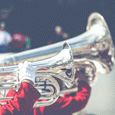It may seem that small colleges face a recruiting disadvantage for band students when compared to large universities. The giant stadiums, large marching bands, and media presence certainly lure students away from liberal arts colleges or smaller regional universities. However, for every student who dreams of attending a state flagship university and marching in a huge collegiate marching band, there is another student who prefers a more personal collegiate environment and would gladly participate in a small but high-quality marching or basketball band. With the right approach, a small college can capitalize on its strengths and develop a comprehensive athletic band program.
For the past two years, I have been Director of Athletic Bands at North Central College, a small, liberal arts institution in Illinois with an enrollment of 2,700 undergraduates. I have discovered that given the sheer number of students who participate in high school marching or basketball bands, the potential exists to build athletic band programs at many small institutions. In 2016 alone, over 400 North Central applicants indicated an interest in band. We have successfully implemented recruiting programs that have nearly doubled the size of our athletic band program in one year.
Taking Advantage of Admissions Department Programs
A key first step in recruiting is to establish a relationship with the Admissions office, and this begins with participating in annual recruiting events. Most admissions departments regularly operate student visit days that include open houses or activity fairs. By participating in these events, you can reach many students at once, and meeting in person makes it easier for students to imagine themselves in your program. These activity fairs also offer a prime opportunity to develop a short list of the prospective band students most likely to attend your school. Before each activity fair, print out a contact form for prospects; alternatively, having a laptop computer or tablet at the fair can cut down on time spent deciphering questionable handwriting.
When students visit an admissions event, present your program as a model of organization and professionalism. Because time with students and parents is limited, prepare a short list of talking points about the program and then provide them with eye-catching literature to take home. With most of the work done for you, admissions events are especially beneficial for part-time or adjunct directors who are on campus for a limited amount of time each week.
With prospective students who visit outside of pre-planned events, you have time to answer questions, learn about the student’s background and interests, and explain the structure and philosophy of your program. Parents, in particular, are particularly appreciative of directors who thoroughly answer all of their questions (often about scholarships, fees, and course credits) because they frequently help to pay tuition. To manage an individual student visit effectively, you should communicate regularly with the Office of Admissions. Each term, I inform our admissions representative of my teaching schedule to make it easy to schedule a one-on-one meeting between the student and me. This streamlined process strengthens the perception of our institution as a well-oiled machine.
Implementing Band-Centered Recruiting Activities
Beyond admissions events and student visits, there are many opportunities to develop recruiting activities that can provide prospective students with a more complete understanding of your athletic band program. In 2012, while considering doctoral wind conducting programs, I visited several schools with large and highly visible athletic bands. The University of Oklahoma put together an itinerary that included shadowing the band staff throughout an entire game day. After a full day with the faculty and students and considerable exposure to the culture of the university, I arrived at home excited and determined, and returned one month later to complete my formal audition. No other campus visit matched the insight I gained or camaraderie I developed. I was sold.
I initiated a similar Marching Band Game Day Guest program at North Central College in 2016. The day begins with a meeting in my office to introduce myself and answer initial questions that students or parents might have. We then proceed to the band’s pre-game staging and warm-up area, where the visiting students meet the members of their sections. When preparing to march to the stadium, the student guests are placed into the parade block next to their respective section leaders, who then teach them their section’s horn flashes, chants, and cheers. While the band marches, I escort the parents and answer their questions. Once in the stands, the prospective students sit with band members, where they have the option of playing along with the stand tunes. Some students are eager to play, but others feel insecure about their ability and prefer to watch.
While the band performs at halftime, I invite the visiting students to stand on the sideline with the staff. Our band holds a meaningful ceremony after each game that includes singing the alma mater, speeches by the drum majors, and a traditional song that we play to honor our seniors. Upon its conclusion, I thank visiting students for their participation and emphasize my willingness to answer any questions throughout their application process. The guest program has been very successful and word-of-mouth has spread throughout the year, resulting in increased participation at each game. Current band members have also marketed the event by sharing the registration website with their high school band directors and friends.
For colleges without a marching band, there are many opportunities during basketball season for similar recruitment activities. Each winter, we reach out to area high school band directors and arrange for North Central students to play with high school pep bands at their basketball games. In return, we invite the high school band members to come to North Central and play at our home games. This exchange program is remarkably easy to organize and execute, but the impact cannot be understated. After we initiated this program, enrollment by band students from participating high schools increased, sometimes dramatically. We provide this opportunity for individual prospective students as well. This is especially useful for students who participate in competitive high school marching bands and cannot attend a football game due to busy Saturday schedules. By playing with the basketball band, they can still experience the culture of the college and band program. As you develop your own recruiting events, keep the admissions office informed at every step.
Student Follow-Up
Follow up with prospects in an unobtrusive manner. For all prospective students who take part in a recruiting event, a short post-visit email is a polite way to bring their on-campus experience to a final cadence. Before sending the email, determine if the student has completed their application. This will probably come to light throughout your interactions with the student and parents at the visit, but if not, ask the admissions office. If the student has not completed the process, a gentle reminder of application deadlines shows that you are interested in their success. Check periodically with admissions to determine who has committed to your institution. When a student commits, send another message congratulating them on their decision and including the important dates and deadlines for the summer and fall term.
Remember that at this point in the academic year, recruits are juggling high school responsibilities along with college visits and auditions. Don’t be pushy or overwhelm them with detail. Specifics about the upcoming season can wait. Just make sure that they understand the structure of the season so they (and their parents) can plan their summer vacations and work schedules and know when they will move into residence halls for band camp.
Databases and Phone Banks
Despite the best efforts of the admissions office, some prospects will slip through the cracks. Most college applications include questions on areas of interest, which typically include band. Gaining access to this data is the first step in finding elusive potential band students. Many institutions use a program such as Entrinsik Informer, which allows this information to be shared. By requesting access to information concerning students interested in band, you can create a calling list. At small colleges such as North Central, there are often between 400 and 600 applicants interested in band annually. By focusing first on those who have committed to your college, and then on those who have completed applications and have been accepted, and finally on those with pending or incomplete applications, you can set priorities and maximize results.
Do not attempt this task alone. If you have a leadership team, identify two or three evenings over a week or two to call potential band students. Ask current band members to help with these phone bank sessions. Before the first calls are made, you should compose a script for callers. Allow them to practice on each other and offer guidance as questions arise. Be sure to write a script for voicemail messages that includes the phone number you would like prospective students or parents to call. Some calls might be rocky but parents and prospective students typically look past any awkwardness and appreciate the effort.
You will gain considerable information from the phone calls. Some applicants will say that they are no longer considering your institution, and others will ask questions that only admissions representatives can answer. Instruct your callers how to respond to each of these scenarios and have them record this information in a call log. Provide a copy of all logs to your admissions office. Calling up to 600 students is a tremendous but rewarding effort. At North Central, we typically add twenty to thirty students through the phone bank.
Recruiting for an athletic band program at a small college can be challenging, but by increasing your visibility by building relationships in the schools and community, there is tremendous potential to build successful and vibrant program marching and basketball band programs. The most important factor for students interested in small colleges is the professional, interpersonal relationship with their mentors and classmates. Developing a recruiting program gives students a sense of camaraderie and the knowledge that they are joining an organized and professional program, you will set your students and your program up for long-term success.
North Central College Athletic Band Recruiting Calendar
July through October
1. Participate in All Admissions Department Visit Days and Activity Fairs
The foundation of your recruiting efforts should be participation in the large-scale events organized by the admissions department. Participate in all such initiatives, as they bring together large numbers of prospective students and the bulk of the work is done for you.
2. Reach Out to Civic Band/Music Leaders in the Community
Reach out to area high school band directors, community or civic band conductors, and music store managers. Request to give a beginning-of-marching-season greeting at local high school band camps.
3. Implement Marching Band Game Day Guest Program
I recommend establishing this program no earlier than the director’s second year in a position. In the first year, it is imperative to focus on getting to know students and colleagues.
4. Offer to Serve as a Clinician to Area High Schools
Many high school band directors would love outside help, especially before competitions and major performances. Start by reaching out to any alumni band directors in the area and then branch out geographically. Established colleges with strong programs will have easier access.
5. Invite a High School Marching Band to Share Halftime
If your season permits, invite a local high school band to split halftime with your band or participate in a combined show. Since most small colleges do not have marching bands and even fewer have bands that travel to away games, there is typically ample time at halftime for such an event. For split halftimes, be sure to communicate the per-band performance time to the visiting director so that they can rehearse the cuts to their show. Similarly, be sure to shorten your show to fit within the given time frame. Some conferences—especially in NCAA Division III—also require time at the end of halftime for football player warm ups, so make sure to troubleshoot your itinerary with the athletic director. A combined performance would require more preparation and a rehearsal with both bands earlier in the game day, but it might make the timeline more manageable and the product effective.
6. Participate in Music Department Early Audition Day
Most institutions offer an early audition day, typically in November. This permits prospective students who are ready to commit to audition for acceptance and scholarships.
November-February
1. Request Admissions Database Access
It is important to have access to the database the admissions office uses to track applicants with band and color guard interest. If your admissions office currently does not track band/color guard interest, ask that a field or question be added to the application.
2. Continue to Participate in All Admissions Department Visit Days and Activity Fairs
With the peak of the recruiting and admissions season falling in February and March, it is important to maintain high visibility throughout the year. Your interaction with a student might be the deciding factor in picking your school.
3. First Round of Phone Calls: Early Admission Deadline
Most institutions have an early application deadline that typically offers a waived application fee, and sometimes includes access to additional scholarships or financial aid opportunities. Just after the early admissions deadline, check the admissions database. For each student who has committed to your institution and has indicated an interest in band, make a congratulatory phone call and inform them of your program offerings. If students are interested, you can often add them to your roster or add them to your recruiting “short list.”
4. Game Day Guest Program- Basketball
In the same vein as marching guest program, the goal of the basketball guest program is to immerse students in the game day experience. Basketball games involve far fewer logistical considerations, making this activity an easy addition to a recruitment program.
5. Music Department Audition Days
Participate in every music department audition day. Students will be nervous, and therefore a smile and a kind word from the athletic band director can make them feel appreciated.
6. Host Special Events
If you have the ability to host large-scale events, you can easily create opportunities for outreach among these visiting students and their families. Such events might include honor bands and concert or jazz band festivals. By involving current band students as volunteers, you can establish a rapport between the visiting and current students, making them feel more welcomed and comfortable.
7. Invite a Local High School Band to Participate in an Invitational Concert
Especially if you have a strong concert band program or impressive performance facilities, this is an effective way to get a large number of prospective band students on campus. Ask the admissions office to organize tours, dinner in the dining facilities before the concert, and a bag for each student with brochures and souvenirs.
March-June
1. Offer to Serve as a Clinician for Local High School Concert Bands Before Festivals and Assessments
Offer your services to music education associations or school districts that run adjudicated events, festivals, or clinics. For college band directors, a clinician role is preferred, as it allows time to demonstrate knowledge and build rapport with students and directors.
2. Second Round of Phone Calls: Large-Scale Phone Bank
Roughly three weeks before the regular application deadline, assemble a group of students to call each applicant who has indicated an interest in band. This process might involve several hundred applicants, so be sure to sort the information in a manner that makes the best use of your time, such as starting with committed students, then accepted-but-uncommitted students, and finally, pending applicants. Remember to include transfer students in this list. Filter out applicants who have attended other recruiting events or who have already met or spoken with you individually.
3. Late Music Department Audition Day and Individual Auditions
For myriad reasons, some students take longer to decide or get off to a late start on their applications. Nevertheless, it is important to offer them the same time and expertise as other prospects.
4. Final Round of Phone Calls: Late Applicants
New students will appear on the band interest database throughout the spring. Be sure to check the list for new names or students who have moved from accepted to committed.
5. Determine a Deadline for Marching Band Enrollment
If your band marches, you must consider the timeline of your drill writer. If you write your own drill, you can be more flexible.
6. Final Outreach
Contact, either via email or telephone, any student still on the fence or that you have not reached.







